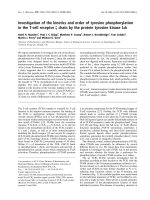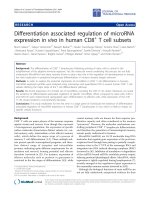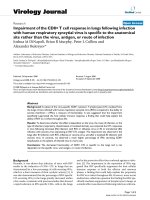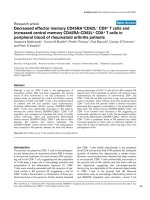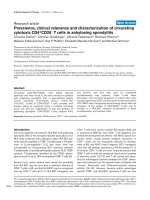Immunodominance and immunoprotection of anti viral specific CD8+ t cell response during HBV infection
Bạn đang xem bản rút gọn của tài liệu. Xem và tải ngay bản đầy đủ của tài liệu tại đây (8.48 MB, 108 trang )
IMMUNODOMINANCE AND IMMUNOPROTECTION
OF ANTI-VIRAL SPECIFIC CD8+ T CELL RESPONSE
DURING HBV INFECTION
TAN ANTHONY TANOTO
(B.Sc. (Hons.), NUS)
A THESIS SUBMITTED
FOR THE DEGREE OF DOCTOR OF PHILOSOPHY
(YONG LOO LIN SCHOOL OF MEDICINE)
DEPARTMENT OF MEDICINE
NATIONAL UNIVERSITY OF SINGAPORE
2012
i
ACKNOWLEDGEMENTS
Firstly, I would like to thank Dr. Antonio Bertoletti, my supervisor, for his
constant guidance and patience throughout the entire duration of the project.
More importantly, his trust in my decisions has allowed me to mature in thought
and as a scientist. For that I am extremely grateful. I would also like to thank
Dr Adam Gehring for his input in the project and the initial laboratory training
that he has given several years back, which forms the foundation for the skills I
have learned through the years; Mr Ho Zi Zong and Miss Adeline Chia for their
numerous assistance; and all the members (both past and present) of the
laboratory who have contributed in one way or another. Special thanks also go
out to Kelly for her support and understanding as I pursue my PhD degree.
ii
TABLE OF CONTENTS
Content Page
Acknowledgements i
Summary iii
List of Tables vi
List of Figures vii
List of Abbreviations viii
1. Background 1
1.1. Hepatitis B virus (HBV) 2
1.2. HBV Genotypes 2
1.3. HBV-specific Immune Response 3
1.3.1. Latent Phase 4
1.3.2. Viral Replication Phase 5
1.3.3. Adaptive Immunity Phase 6
1.4. Current Work 8
1.5. Tables and Figures 10
2. Chapter 1 – Immunodominance of HBV-specific T cells 12
2.1. Introduction 13
2.2. Materials and Methods 16
2.3. Results 23
2.4. Discussion 32
2.5. Tables and Figures 37
2.6. Supplementary Tables and Figures 46
iii
3. Chapter 2 – Immunoprotection of HBV-specific T cells during hepatic
flares 48
3.1. Introduction 49
3.2. Materials and Methods 51
3.3. Results 56
3.4. Discussion 64
3.5. Tables and Figures 70
3.6. Supplementary Tables and Figures 80
4. Concluding Remarks 83
References 85
Appendix 94
Relevant Publications
Tan, A. T., E. Loggi, C. Boni, A. Chia, A. J. Gehring, K. S. Sastry, V.
Goh, P. Fisicaro, P. Andreone, C. Brander, S. G. Lim, C. Ferrari, F. Bihl,
and A. Bertoletti. 2008. Host ethnicity and virus genotype shape the
hepatitis B virus-specific T-cell repertoire. J Virol 82:10986-10997.
Tan, A. T., S. Koh, W. Goh, H. Y. Zhe, A. J. Gehring, S. G. Lim, and A.
Bertoletti. 2010. A longitudinal analysis of innate and adaptive immune
profile during hepatic flares in chronic hepatitis B. J Hepatol 52:330-339.
Tan, A. T., S. Koh, V. Goh, and A. Bertoletti. 2008. Understanding the
immunopathogenesis of chronic hepatitis B virus: an Asian prospective.
J Gastroenterol Hepatol 23:833-843.
A. Bertoletti, Tan A. T. and A. J. Gehring. 2009. HBV‐specific adaptive
immunity. Viruses 1:91‐103.
iv
Watanabe, T., A. Bertoletti, and T. A. Tanoto. 2010. PD-1/PD-L1
pathway and T-cell exhaustion in chronic hepatitis virus infection.
Journal of viral hepatitis 17:453-458.
Other Publications
Gehring, A. J., Z. Z. Ho, A. T. Tan, M. O. Aung, K. H. Lee, K. C. Tan,
S. G. Lim, and A. Bertoletti. 2009. Profile of tumor antigen-specific CD8
T cells in patients with hepatitis B virus-related hepatocellular carcinoma.
Gastroenterology 137:682-690.
Sandalova, E., D. Laccabue, C. Boni, A. T. Tan, K. Fink, E. E. Ooi, R.
Chua, B. Shafaeddin Schreve, C. Ferrari, and A. Bertoletti. 2010.
Contribution of herpesvirus specific CD8 T cells to anti-viral T cell
response in humans. PLoS Pathog 6(8): e1001051.
v
SUMMARY
The Hepatitis B virus (HBV) is a non-cytopathic hepatotropic DNA virus,
with a host range limited to humans and chimpanzees. Despite the availability
of a prophylactic vaccine, approximately 350 million individuals are chronically
infected worldwide and it is one of the leading causes of hepatocellular
carcinoma (HCC). Depletion of T cells in experimentally infected chimpanzees
and the longitudinal analysis of T cell responses in both acute and chronic
patients have shown the crucial importance of T cells in the control and
clearance of HBV infection. This thesis will focus on two aspects of T cell
responses during HBV infection, namely: 1) the factors that influence the
immunodominant hierarchy of HBV-specific T cells and 2) immunoprotection of
HBV-specific T cells during hepatic flares (HF).
Chapter 1 – Immunodominance of HBV-specific T cells
Repertoire composition, quantity and qualitative functional ability are the
parameters that define virus specific T cell responses and are linked with their
potential to control infection. By taking advantage of the segregation of
different HBV genotypes in geographically and genetically distinct host
populations, we were able to directly analyze the impact that host and virus
variables exert on these virus-specific T cells parameters. T cell responses
against the entire HBV proteome was analyzed in a total of 109 HBV infected
Chinese or Caucasian subjects. We demonstrate that HBV-specific T cell
quantity is determined by the virological and clinical profile of the patients,
which outweighs any influence of race or viral diversity. In contrast, HBV-
specific T cell repertoire is divergent in the two ethnic groups with T cell
vi
epitopes frequently found in Caucasian patients seldom detected in Chinese
patients, demonstrating the ability of HLA micro-polymorphisms to diversify
the T cell response. In conclusion, we provide a direct biological evaluation of
the impact that host and virus variables exert on the immunodominance of virus-
specific T cell response.
Chapter 2 – Immunoprotection of HBV-specific T cells during hepatic flares
The pathogenesis of HF in patients chronically infected with HBV is
controversial. Since HBV is not a directly cytopathic virus, an increase in virus-
specific T cell response has been conventionally thought to occur during HF,
even though experimental evidence to support such a scenario is scarce.
Therefore, we studied the kinetics of innate and adaptive immune activation
during HF in chronic hepatitis B to answer the following questions of
immunoprotection: a) Is the HBV replication rebound that precedes HF
associated with activation of innate or adaptive immunological events?; b) Are
HF associated with the recovery of HBV-specific immunity? We analyzed
longitudinally soluble (IFN-α, IL-1β, TNF-α, IL-6, IL-8, IL-10, CCL-2, CCL-3,
CXCL-9, CXCL-10) and cellular (HBV-specific T, NK and T-regulatory cells)
immunological parameters in patients (n=5) who developed HF after anti-viral
therapy withdrawal, and cross-sectionally in chronic (n=29) and acute hepatitis
B patients (n=5). A progressive increase of HBV replication precedes HF but
occurs without detection of innate immune activation, with the exception of
increased serum CXCL-8. Despite the absence of increased circulatory HBV-
specific T or activated NK cells, HF were temporally associated with high serum
levels of IFN-γ inducible chemokines CXCL-9 and CXCL-10 (but not CCL-2 or
vii
CCL-3). CXCL-9 and CXCL-10 also displayed different in vitro
requirements for activation and are differentially produced in liver injury
present in acute or chronic patients. In conclusion, we demonstrate that both
HBV replication rebound and HF were not associated with a recovery of
peripheral HBV-specific T cell immunity and confirm that CXCL-9 and CXCL-
10 are major mediators of liver inflammation. Their differential expression in
acute versus chronic patients also suggests the presence of different mechanisms
that govern liver injury during acute and chronic hepatitis B.
viii
LIST OF TABLES
Tables Page
Chapter 1
Table 1. Tabulated summary of CD8+ T cell responses against known
HLA-A2 restricted epitopes in HLA-A2+ Chinese and
Caucasian patients 37
Chapter 2
Table 1. Longitudinal clinical data of patients who withdrew from
Remofovir treatment 70
ix
LIST OF FIGURES
Figures Page
Background
Figure 1. Geographical distribution of HBV genotypes. 10
Figure 2. Immunological progression of HBV infection. 11
Chapter 1
Figure 1. Ex vivo quantitative profile of HBV-specific T cells in
Chinese and Caucasian HBV patients 38
Figure 2. Quantification of HBV-specific T cells after in vitro
expansion 39
Figure 3. Quantification of IFN-γ production in acute and chronic
Chinese patients 40
Figure 4. Induction of CD8+ T cell response against known A2-
restricted epitopes in HLA-A2+ Oriental and Caucasian
patients 41
Figure 5. Hierarchy of HBV-specific CD8+ T cell response in a HLA-
A0206 and a HLA-A0203 Chinese acute HBV patient 42
Figure 6. Functional presentation of Core18-27 by HLA-subtypes
common in the Chinese population 43
Figure 7. Time course analysis of Core18-27 epitope presentation by
HLA-A2 subtypes 44
Figure 8. Influence of amino acid variations within different genotypes
in T cell recognition 45
x
Chapter 2
Figure 1. Temporal dissociation of viral rebound and hepatic injury 72
Figure 2. Pro-inflammatory and anti-inflammatory cytokine profile of
the distinct disease phases 73
Figure 3. Strong correlation of serum CXCL-9 and CXCL-10
concentrations with hepatic injury 74
Figure 4. Quantification of HBV-specific T cells, NK cells and Treg 76
Figure 5. Contribution of cellular and secreted factors in CXCL-9 and
CXCL-10 production by human hepatocytes 78
xi
LIST OF ABBREVIATIONS
ALT Alanine aminotransferase
ELISPOT Enzyme-linked immunosorbent spot assay
HBV Hepatitis B virus
HBV
genA
HBV genotype A
HBV
genB
HBV genotype B
HBV
genC
HBV genotype C
HBV
genD
HBV genotype D
HBcAg Hepatitis B core antigen
HBeAg Hepatitis B core antigen (secreted form)
HBsAg Hepatitis B surface antigen
HCC Hepatocellular carcinoma
HCV Hepatitis C virus
HIV-1 Human immunodeficiency virus type 1
HF Hepatic flares
HLA Human leukocyte antigen
ICS Intracellular cytokine staining
IFN Interferon
IL Interleukin
MCMV Murine cytomegalovirus
PBMC Peripheral blood mononuclear cells
PBS Phosphate buffered saline
Peg-IFN Pegylated interferon
PD-1 / PD-L1 Programmed death 1 / Programmed death 1 ligand
PHA Phytohemagglutinin
SEB Staphylococcal enterotoxin B
SFU Spot forming units
Th1 T-helper 1
TLR Toll-like receptors
TNF-α Tumour necrosis factor - alpha
Treg Regulatory T cells
BACKGROUND
Background
1
BACKGROUND
The Hepatitis B virus (HBV), a member of the Hepadnaviridae virus family, is a
non-cytopathic hepatotropic DNA virus, with a host range limited to humans
and chimpanzees, a worldwide distribution, and an ability to cause liver diseases
with varying severity in different individuals
1, 2
. Even with the availability of
an effective prophylactic recombinant vaccine, it is estimated that two billion of
the global population have been infected with the virus before and that the
worldwide HBV related deaths amount to 500 000 – 700 000 each year
3
.
Among the HBV infected subjects, some were able to control the infection and
clear the virus from the bloodstream without any clinically evident symptoms
(sub-clinical infection) or with an acute inflammation of the liver (acute
hepatitis) that resolves without persistent secondary clinical complications
2
.
However, some patients are unable to clear the virus and develop chronic
infection, defined as subjects positive for hepatitis B surface antigen (HBsAg)
for more than six months
4, 5
. An estimated 350 million individuals are
chronically infected with HBV worldwide, with a high incidence occurring
particularly in Asia
6
. Most chronic HBV subjects remain largely asymptomatic
without the development of severe liver diseases, but approximately 15-40% of
HBV carriers progress to develop fibrosis, cirrhosis, liver failure and
hepatocellular carcinoma (HCC)
7
. Furthermore, greater than 50% of primary
HCC is related to HBV infection, making it the leading cause of HCC
8
.
Background
2
Hepatitis B Virus (HBV)
The HBV genome is circular and partially double stranded consisting of
approximately 3200 nucleotides contained in an icosahedral capsid that is
enveloped by a lipid bilayer
9, 10
. The genome contains four overlapping open
reading frames that codes for seven polypeptides; the structural nucleocapsid or
core protein (containing the core antigen, HBcAg) and the three variants of the
surface envelope proteins (containing the surface antigen, HBsAg) with the pre-
S2 section, with both pre-S1 and pre-S2 sections or without both sections, the
non-structural viral polymerase, the secretory form of the pre-core protein
(containing the antigen, HBeAg) and the X protein
9, 10
.
The core and envelope proteins have a structural function, where it is involved
in the encapsidation of the viral RNA/DNA, and the coating of the entire virus
particle upon budding respectively
9, 10
. The function of the secreted pre-core
protein is unknown but it may have a role in the suppression of the HBV
specific immune response. The X protein is a transactivator of both viral and
cellular genes, and is believed to be involved in the development of HCC in
chronically infected individuals though it is yet to be conclusive
10, 11
. In
addition to the DNA polymerase activity, HBV polymerase also has a reverse
transcriptase activity and an RNAse H activity that removes the RNA
component of a DNA/RNA duplex, but it lacks proofreading capabilities
11
.
HBV Genotypes
The lack of proofreading capacity of the HBV polymerase has resulted in
sequence heterogeneity due to increased mutation rates, as such the virus
Background
3
population at any given time can be perceived to be composed of various
mutants
12, 13
It is this extensive variation that demands HBV to be classified
into eight genotypes (A-H) based on an intergroup divergence of more than 8%
in the complete genome sequence and 4% in the HBV surface protein gene
14
.
Subtypes have also been described in genotypes A, B, C and F
14
.
Interestingly, the different HBV genotypes have a distinct geographical
distribution (Figure 1.). Genotypes B and C are characteristically found in Asia
with genotype B infecting majority of South-East Asian individuals, while
genotype A and D are more commonly associated with HBV infections in
Europe and North America
8, 14
. Furthermore, literature has suggested the
possibility of the different genotypes to influence disease severity, likelihood of
complications and response to treatment of chronic HBV infections
15, 16
.
Studies comparing HBV genotype B and C showed that genotype B is
associated with earlier spontaneous HBeAg seroconversion with or without
pegylated IFN (Peg-IFN) treatment, slower progression to cirrhosis as well as a
less frequent and slower development of HCC than genotype C
17-19
. However,
findings from HBV genotype comparison studies are often conflicting, hence a
definitive role of HBV genotypes in HBV infection has yet to be established
15
.
HBV-specific Immune Response
The general immunological progression pattern following HBV infection
consists of three distinct stages: an early latent phase where viral replication and
host immune response against HBV is undetectable, a rapid viral replication
phase with the activation of innate immunity and an adaptive immunity phase
Background
4
that differs between acute and chronic patients (Figure 2.)
20
. Patients that
proceed to resolve the infection have a robust HBV specific adaptive immune
response as opposed to patients who develop chronicity where such adaptive
immune response is weak or absent (Figure 2.)
20
. Various critical events in
each of the different phases are believed to affect the eventual outcome of the
infection and determine if chronicity develops.
Latent Phase
Unique to HBV, the virus does not replicate efficiently immediately after
infection, instead it requires 4-7 weeks of incubation period before HBV-DNA
and antigens reach a detectable level in the serum
21
. Detailed longitudinal
analyses of global gene expression in infected chimpanzees revealed that
antiviral cytokine genes like interferon (IFN) α and β are either weakly or not
triggered during the latent phase
22
. Therefore, it seems that the initial latent
phase is unlikely attributed to an immune mediated inhibition of HBV
replication, but more of an escape mechanism utilized by the virus. One
possible explanation for the absence of IFN α and β genes activation has been
suggested to be the consequence of the viral life cycle where the viral genetic
material is encapsidated, preventing host cellular recognition
22
. Furthermore,
there is accumulating evidence to suggest that HBV might even interfere with
the expression of Toll-like receptors (TLRs), in particular, reduced expression of
TLR-2 has been observed in hepatocytes, Kupffer cells and monocytes of
HBeAg positive chronic patients and in HBeAg-expressing HepG2 lines
23
.
However, such early events in the natural infection of HBV are hard to analyse
in human subjects as the diagnosis of HBV infection usually occurs past this
Background
5
phase when clinical symptoms emerge, thus the impact of this latent period on
the course and outcome of HBV infection remains largely unknown.
Viral Replication Phase
The phase immediately after the rapid expansion of HBV is an important link
between the innate immunity and the activation of adaptive immunity against
HBV. The same study by Wieland et al. (2004) showed that chimpanzees with a
typical acute HBV infection profile had a robust induction of T helper type 1
(Th1) genes including IFN-γ, tumour necrosis factor α (TNF-α) and RANTES
immediately after the latent phase. However, experimentally infected
woodchucks that develop chronicity seem to lack the initial large production of
Th1 cytokines
24, 25
. In line with observations in the woodchuck model of HBV
infection, the development of chronicity is clinically associated with the absence
or mild symptoms of hepatitis, while patients who resolve the infection often
experience acute hepatitis
20
. This led to the suggestion that the ability of the
innate immunity to produce large amounts of IFN-γ or Th1 cytokines might
influence the activation of the adaptive immunity and determine the eventual
likelihood of developing chronicity
20
. Even though the mechanisms of innate
immunity activation during HBV infection is still unclear, immunological events
occurring during the initial phases of infection seems to have a profound effect
on the eventual development of the adaptive immune response and the outcome
of the infection.
Background
6
Adaptive Immunity Phase
The important role of the adaptive immunity in determining the outcome of a
HBV infection has been demonstrated through various studies, both in
experimentally infected chimpanzees and in patients
21, 26-34
. This antiviral
ability requires both the humoral and cellular arm of the adaptive immune
system as well as a complex interplay between the different components
35
.
The humoral arm typically provides protection through the production of
neutralizing antibodies against viral particles, preventing infection in a similar
fashion to HBV vaccination. In particular, HBV clearance has been associated
with the production of anti-HBs antibodies
36
, and sera with high levels of anti-
HBs antibodies have been shown to be able to control HBV infection
37
. Even
though the humoral immune response does play a role in the control of HBV,
this branch of the adaptive immunity seems comparatively unexplored in the
context of HBV infection. On the other hand, T cell responses have been widely
studied in HBV. Depletion of CD8 or CD4 T cells in chimpanzees that have
been experimentally infected with a HBV innoculum size that typically causes
an acute infection, results in a prolonged and persistent infection
21, 26
.
Clinically, the expansion of HBV-specific CD8 and CD4 T-cells has also been
observed to precede viral clearance and was present only in patients who
controlled the infection
21, 32
. Furthermore, the longitudinal analysis of a HBV
and HCV co-infected individual who developed chronic HBV infection shows
the presence of multi-specific CD8 T-cells with the absence of CD4 T-cells
38
.
This suggests that the absence of CD4 cytokine help prevented the proper
maturation and subsequent functioning of the CD8 T-cells. Clearly, these
Background
7
studies support the necessity of a functional and coordinated CD8 and CD4 T
cell response for HBV control and clearance. In addition to their discrete
antiviral role, the humoral and cellular components of the adaptive immune
system are also interconnected in a way that the failure of one of them clearly
affects the expansion and protective efficacy of the other. A lack of CD4 T cell
help can impair CD8 T cell activity and antibody production
39
, while the
inability to mount a virus-specific CD8 T cell response results in a level of
circulating virus that cannot be cleared by antibodies alone
40
, supporting the
notion of a complex interplay between the different components of the adaptive
immunity.
Considering the importance of T cells in HBV control and clearance, the T cell
response greatly differs between patients with a self-limiting infection and those
who develop chronicity. Data from multiple groups have established the idea
that chronically infected subjects are generally characterized by a weak or
undetectable virus-specific T-cell response as opposed to acutely infected
subjects where cytotoxic and helper T-cell responses are quantitatively stronger
27-34
. Though the mechanisms responsible for the lowered T-cell response are
not fully known, evidences favour the concept of anergy, exhaustion and
deletion of HBV specific T-cells mediated by high doses of viral antigen
20, 35
.
In particular, two viral proteins regulated by the quantity of HBV replication
have been shown to operate in this fashion. HBeAg can suppress the immune
response against HBcAg in adult T-cell receptor transgenic mice
41
. This cross-
reactivity of HBeAg can then delete or anergize HBcAg specific T-cells, thereby
contributing to viral persistence in chronically infected subjects. The other
Background
8
protein, HBsAg, might also suppress the immune response against HBV by
acting as a high-dose tolerogen, as high serum levels of HBsAg are
characteristic of chronically infected subjects
20, 42
. It is possible that this
perpetually high antigen load can constantly activate the HBsAg specific T-cells
causing activation induced deletion and anergy, resulting in the subnormal levels
or sometimes absent HBsAg specific CD8
+
T-cells in chronically infected
subjects
31, 43
. It is important to note that other mechanisms, like the infiltration
of T-regulatory cells into the liver
44, 45
, dendritic cell defects
46-49
, low level of
MHC class I expression on hepatocytes
50
and the liver micro-environment,
could also act in a non-mutually exclusive fashion and contribute to the
dichotomous T cell response profile of acute and chronic HBV patients
20, 50
.
However, strong evidence to demonstrate their contribution is currently still
lacking.
Current Work
Even though there exists a wealth of information about the T cell response in
HBV infection, some aspects are still unclear. In particular, questions of
immunodominance and immunoprotection remain unanswered. This thesis will
focus primarily on these two aspects. Chapter 1 will discuss how host and virus
variables influence the immunodominant hierarchy of the T cell response
30
.
More specifically, it describes the quantitative, functional and repertoire profile
of HBV-specific T cells in a wide population of HBV infected Chinese and
Caucasian patients. This comparison demonstrates for the first time the
similarities and differences in the HBV-specific T cell response profile of
Chinese and Caucasians patients, which is a valuable information considering
Background
9
that 75% of chronic HBV patients reside in Asia
51
. Chapter 2 will cover the
issue of immunoprotection during acute exacerbations of liver damage known as
hepatic flares (HF)
52
. A longitudinal analysis of virological and immunological
parameters, both cellular and secreted, performed during HF in chronic HBV
patients allows for the understanding of immunological events that mediate HF
and gives insight to the immunoprotective capacity of HBV-specific T cells
during this pathological condition.
Background (Tables and Figures)
10
Figure 1. Geographical distribution of HBV genotypes. Genotypes B and C are most
commonly found in Asia, while genotypes A and D are primarily associated with HBV
infections in North America, Europe, Middle East and Russia. Genotype E appears to be
confined only to the African continent. Adapted from: Kramvis et. al. (2005)
TABLES AND FIGURES
Background (Tables and Figures)
11
Figure 2. Immunological progression of HBV infection. The general pattern following
HBV infection consists of three distinct phases: an asymptomatic latent phase, a viral
replication phase and an adaptive immunity phase which is robust in acutely infected
individuals but absent or weak in chronically infected patients. Adapted from: Bertoletti
and Gehring (2006).
CHAPTER 1
IMMUNODOMINANCE OF HBV-SPECIFIC T CELLS
